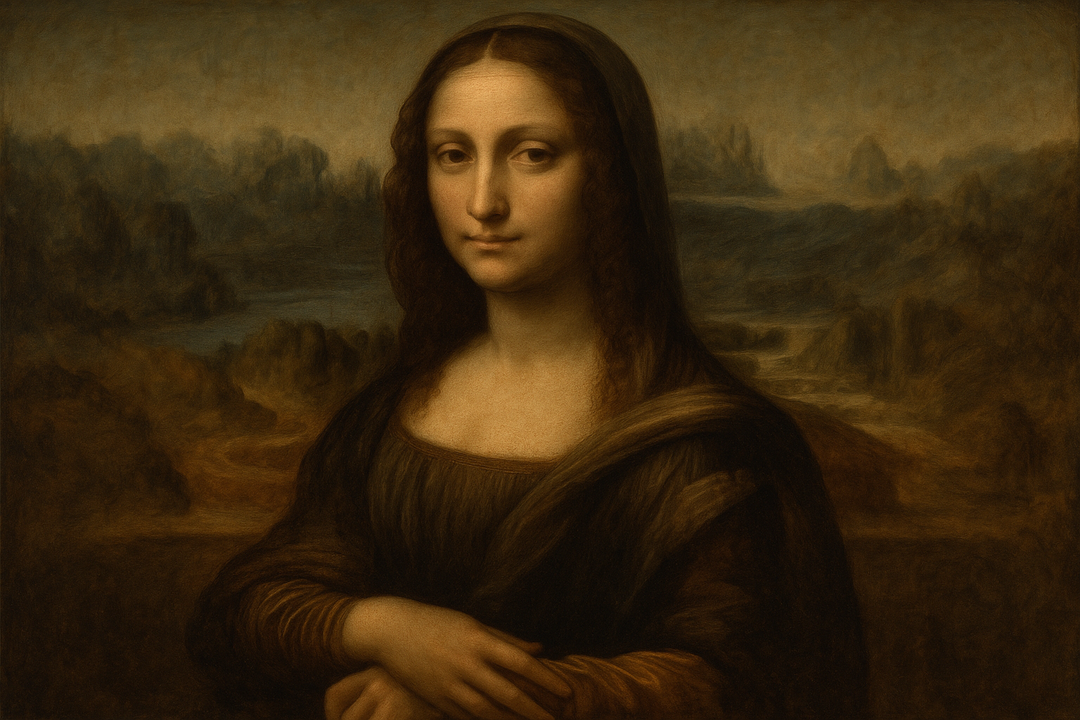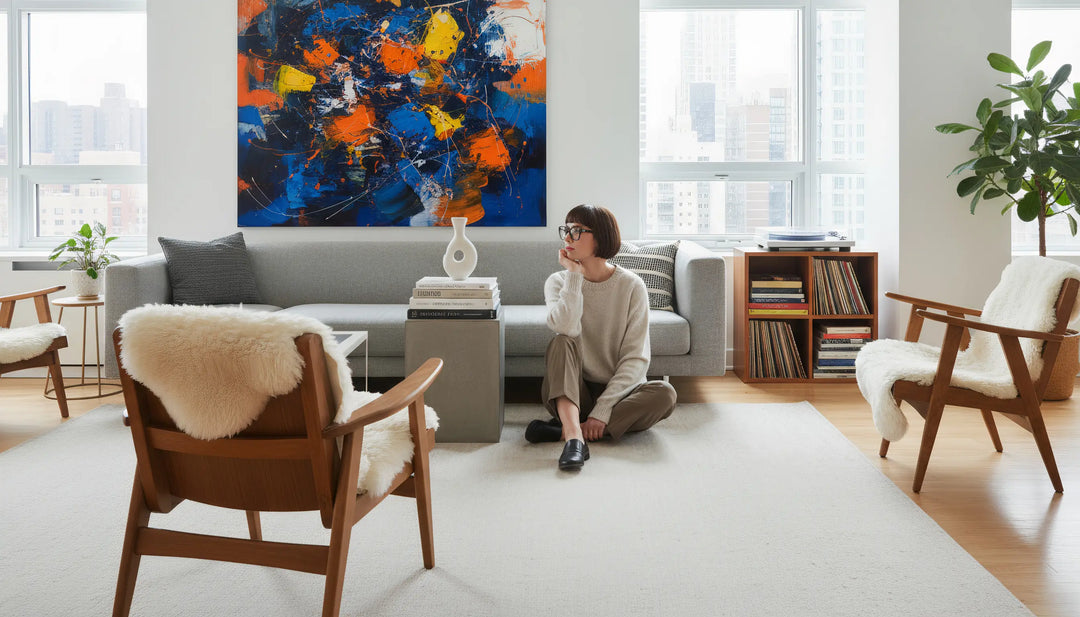Key Takeaways
- Professional frame sizing: Add 2-4 inches on all sides for optimal visual balance
- Weight capacity matters: Drywall supports up to 20lbs with standard anchors, use toggle bolts for heavier pieces
- UV-protective glass preserves artwork for decades, meeting Library of Congress standards
- Proper matting techniques create visual depth and protect prints from direct glass contact
Introduction To Framing Oversized Art Prints
When it comes to making a statement with wall décor, nothing beats the visual impact of framing large prints. Whether it's a piece of oversized artwork or a photograph that holds sentimental value, a well-framed large print can transform any space.

The dramatic difference proper framing makes: transforming a simple print into gallery-worthy art
In this comprehensive guide, we'll delve into the art and science of framing large prints with professional techniques that preserve your investment and create stunning visual impact.
Why Frame Large Prints?
You might be wondering, "Why go through the hassle of framing large prints?" The answer lies in three key areas: visual impact, room ambiance, and art preservation. Let's break it down with specific technical considerations.
Visual Impact & Proper Proportions

Large prints have the power to dominate a room, drawing the eye and setting the tone for the entire space. However, without a frame, these prints can look incomplete or out of place. Professional sizing guidelines recommend:
- Frame Border: 2-4 inches wider than the print on all sides for optimal visual balance
- Wall Proportion: Framed artwork should cover 60-75% of available wall space above furniture
- Height Placement: Bottom edge should be 6-8 inches above furniture for proper viewing angle
Room Ambiance & Design Integration

The frame you choose plays a significant role in setting the ambiance of a room. Whether you opt for a neutral beige frame for a calming effect or a vibrant, colorful frame to add energy, the frame becomes an integral part of your room's design story.
Art Preservation & Archival Standards

Beyond aesthetics, frames serve a critical preservation function. According to Library of Congress preservation guidelines, proper framing protects artwork from:
- UV Radiation: Can cause 40% color fade in just 5 years without protection
- Environmental Pollutants: Dust, smoke, and airborne acids
- Physical Damage: Handling, moisture, and temperature fluctuations
- Acid Migration: From non-archival materials causing permanent staining
Choosing the Right Frame Material
When framing large prints, material selection impacts both aesthetics and structural integrity. Let's examine the pros and cons of each option with specific weight and durability considerations.

Material comparison: Natural oak, black wood, brushed silver, matte black metal, white wood, and walnut
Wood Frames: The Traditional Choice
Wood Frame Specifications
Weight Capacity:
- Oak/Hardwood: Supports up to 50lbs for large formats
- Pine/Softwood: Suitable for prints up to 30lbs
- Engineered Wood: Cost-effective option for prints up to 25lbs
Best Applications: Botanical prints, traditional artwork, and spaces requiring warm, natural aesthetics.
Metal Frames: Modern Durability
Metal Frame Specifications
Material Options:
- Aluminum: Lightweight, rust-resistant, supports up to 40lbs
- Steel: Heavy-duty option for oversized prints up to 75lbs
- Brushed finishes: Hide fingerprints and scratches better
Best Applications: Contemporary spaces, abstract artwork, and high-traffic areas requiring durability.
Material Selection Guide

Professional Recommendation: Consider these factors when selecting frame materials:
- Print Weight: Include glass, matting, and backing in calculations
- Room Humidity: Wood expands/contracts, metal remains stable
- Maintenance: Wood requires occasional care, metal is virtually maintenance-free
- Budget: Quality wood costs 20-40% more than equivalent metal frames
The Art of Professional Matting
Matting is a crucial aspect of professional framing that serves both aesthetic and preservation functions. A mat creates visual separation between artwork and frame while providing archival protection.
Professional Matting Techniques
Mat Width Guidelines by Print Size
- 16x20" prints: 3-4 inch mat borders
- 24x36" prints: 4-6 inch mat borders
- 30x40" prints: 5-8 inch mat borders
- Oversized (40"+ prints): 6-10 inch mat borders
Pro Tip: Larger prints require proportionally wider mats to maintain visual balance and prevent the artwork from appearing "crowded" within the frame.
Archival Matting Standards
Essential Materials for Archival Matting:
- 100% Cotton Rag Board: Museum-quality, lignin-free matting
- Alpha-Cellulose Board: Purified wood pulp alternative
- Archival Mounting Corners: Photo-safe attachment method
- Reversible Hinging: Allows future removal without damage
Color Coordination & Visual Balance
Mat color selection significantly impacts the final presentation. Professional guidelines include:
Mat Color Psychology
- White/Cream: Classic choice, enhances color vibrancy
- Gray: Neutral backdrop, reduces visual competition
- Black: Dramatic effect, makes light colors "pop"
- Colored Mats: Should complement, not compete with artwork
Professional Hanging Techniques for Large Frames
Hanging large frames requires proper hardware, technique, and safety considerations. Improper installation can result in damaged walls, broken frames, or injury.
Wall Anchor Selection Guide
Weight Capacity by Wall Type
Drywall (1/2" standard):
- Standard nail/screw: Up to 10lbs
- Drywall anchors: 15-25lbs
- Toggle bolts: 50-75lbs
- Wall studs (16" centers): 80-100lbs
Plaster Walls: 25-50% higher capacity than drywall
Masonry/Brick: Virtually unlimited with proper anchors
Professional Hanging Wire Setup
Wire Selection and Installation:
- Braided Steel Wire: Most durable, supports 50+ lbs
- Twisted Wire: Economy option for lighter frames
- Wire Tension: Should have 2-3 inches of sag when hung
- D-Ring Placement: 1/3 down from top of frame for optimal balance
Step-by-Step Installation Process
Professional Installation Sequence:
- Measure and Mark: Use a level and measuring tape for precise placement
- Locate Studs: Use electronic stud finder for heavy pieces
- Pre-drill Holes: Prevents wall cracking, especially in plaster
- Install Anchors: Follow manufacturer's torque specifications
- Test Weight: Gently test anchor before hanging artwork
- Add Bumper Pads: Protect wall and keep frame level
Optimal Placement for Large Framed Prints
Proper placement transforms good artwork into stunning room focal points. Professional interior designers follow specific guidelines for optimal visual impact.
Professional Placement Guidelines
Height and Spacing Standards
Standard Hanging Heights:
- Eye Level: Center of artwork at 57-60 inches from floor
- Above Furniture: 6-12 inches clearance from furniture top
- Hallways: Center at 60 inches (standard walking eye level)
- Stairways: Follow stair angle, maintaining consistent spacing
Room Layout Considerations
Furniture Relationship Guidelines:
- Sofa Placement: Artwork should be 2/3 the width of the sofa
- Dining Room: Consider seated vs. standing viewing angles
- Bedroom: Position for comfortable viewing from bed
- Entryway: Create immediate impact, consider traffic flow
Creating Focal Points
Every room has natural focal points where the eye gravitates. Strategic placement principles:
Enhance Your Space with Curated Collections: Consider these placement-ready collections that work beautifully as large statement pieces:
- Contemporary Wall Art Prints - Perfect for modern living spaces
- Vintage Landscape Prints - Ideal for traditional room settings
- Abstract Art Prints - Striking focal points for any room
5 Framing Mistakes That Ruin Large Prints (And How to Avoid Them)
Even expensive artwork can look amateur with poor framing choices. Here are the most common mistakes and professional solutions:
Common Framing Mistakes
- Undersized Frames: Using frames too small for the print creates a cramped appearance. Solution: Follow the 2-4 inch border rule.
- Wrong Glass Type: Regular glass offers no UV protection. Solution: Invest in UV-filtering or museum glass.
- Inadequate Wall Support: Using insufficient anchors leads to fallen artwork. Solution: Always exceed weight requirements by 3x.
- Poor Mat Proportions: Narrow mats make large prints look squeezed. Solution: Scale mat width to print size.
- Ignoring Room Scale: Frames that don't match room proportions look out of place. Solution: Consider ceiling height and wall space.
Caring for Your Large Framed Prints
Proper maintenance ensures your investment retains its beauty and value for decades. Professional care routines make the difference between faded artwork and vibrant displays.
Professional Cleaning Techniques
Safe Cleaning Protocol:
- Glass Cleaning: Use ammonia-free cleaners, spray cloth not glass
- Frame Dusting: Microfiber cloth for wood, damp cloth for metal
- Frequency: Monthly light dusting, quarterly deep cleaning
- Professional Service: Annual inspection for valuable pieces
UV Protection & Environmental Control
Environmental Factors to Monitor:
- Humidity: Maintain 30-50% relative humidity
- Temperature: Avoid locations near heating/cooling vents
- Light Exposure: Limit direct sunlight, use UV window films
- Air Quality: Keep away from kitchen/smoking areas
Budget-Friendly Framing Options
Professional-quality framing doesn't have to break the bank. Strategic choices can reduce costs by 40-60% while maintaining quality and preservation standards.
Cost-Saving Strategies
- Standard Sizes: Use common frame sizes to reduce custom costs
- Acrylic vs. Glass: UV-protective acrylic costs 30% less than museum glass
- Simple Profiles: Basic frame styles cost significantly less than ornate designs
- Group Orders: Frame multiple pieces together for volume discounts
When to Consult Professional Framers
Certain situations require professional expertise to avoid costly mistakes or damage to valuable artwork.
Professional Consultation Recommended For:
- Valuable Artwork: Pieces worth $1,000+ require conservation framing
- Historic Documents: Age and fragility need specialized handling
- Unusual Sizes: Oversized or irregular dimensions
- Complex Mounting: 3D objects, textiles, or mixed media
Conclusion
Framing large prints successfully combines technical knowledge, aesthetic judgment, and quality materials. From selecting the right frame materials and archival matting to professional hanging techniques and proper placement, each element contributes to the final impact.
Transform Your Space Today: Ready to frame your next statement piece? Explore our collections designed specifically for impactful large-format displays:
- Iconic Statement Wall Art Prints - Bold designs for maximum impact
- Famous Artists Wall Art Prints - Museum-quality reproductions
- Photography Wall Art Prints - Stunning large-format photography
Remember that quality framing is an investment in both the artwork and your living space. By following professional standards and techniques, your large prints will provide years of visual enjoyment while maintaining their value and condition.
For more insights into transforming your living spaces with art, check out our guide on creating a symphony of artistry and style in your living room. If you're interested in a more classic approach, don't miss our article on elevating your home with timeless, monochromatic black and white art prints.
Frequently Asked Questions About Framing Large Art Prints
What frame size should I choose for a 24x36 inch print?
For a 24x36 inch print, choose a frame that's 28x40 inches or 30x42 inches, providing 2-4 inches of border on all sides. This creates proper visual balance and allows space for matting if desired. The exact size depends on your wall space and aesthetic preference.
How much weight can my wall support for large framed prints?
Standard drywall supports up to 20lbs with quality anchors, while toggle bolts can handle 50-75lbs. For prints over 30lbs, locate wall studs or use professional-grade anchors. Always use hardware rated for 3x your frame's actual weight for safety.
Is UV-protective glass worth the extra cost?
Absolutely. UV-protective glass blocks 99% of harmful rays that cause fading and can extend artwork life by decades. While it costs 40-60% more than regular glass, it's essential for preserving valuable prints and maintaining color vibrancy over time.
What's the difference between conservation and regular matting?
Conservation matting uses acid-free, archival materials that won't yellow or damage artwork over time. Regular matting may contain acids that can cause permanent staining. For valuable prints, always specify conservation-quality, 100% cotton rag or alpha-cellulose matting.
How high should I hang a large print above my sofa?
Position the bottom edge of your framed print 6-8 inches above the sofa back. The artwork should be approximately 2/3 the width of your sofa for proper proportion. Center it horizontally unless you're creating an asymmetrical design with multiple pieces.
Can I frame large prints myself or should I use a professional?
DIY framing works for prints under $500 in value using standard sizes. For valuable artwork, oversized pieces (over 30x40"), or pieces requiring conservation techniques, professional framing ensures proper preservation and presentation. The cost difference is often justified by the expertise and warranty provided.
What's the best frame material for humid environments like bathrooms?
Metal frames, particularly aluminum, resist humidity better than wood frames which can warp or develop mold. If using wood, ensure it's properly sealed and consider marine-grade finishes. Always use moisture-resistant backing materials in high-humidity areas.

Nikki Sandeman
Art Lover & Décor Specialist
With 15+ years of experience renovating homes and styling living spaces with unique wall art, Nikki helps readers integrate art and décor into modern interiors. Learn more →














